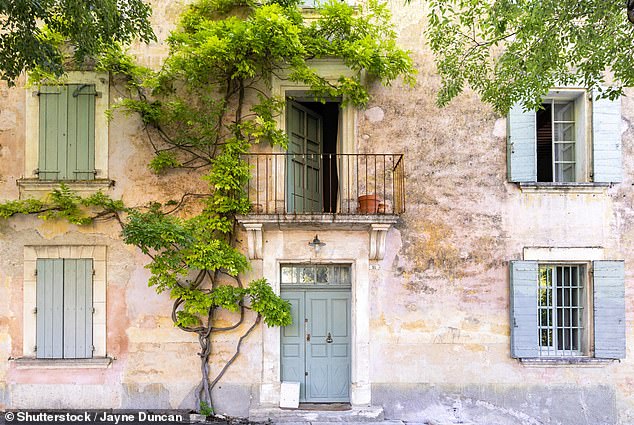I went to France recently and noticed many homes had external window shutters that help block the sun.
My home gets hot in the summer, and I’ve been considering air conditioning – but now I am wondering if these old-fashioned shutters could be a cheaper, greener option.
Are there many companies that fit shutters in Britain? How much will they cost for my four bed detached home and are they worth the investment?
I would only want to fit them on the front of the house, which is south-facing and has four windows.
Finally, my windows open outwards. Would I need to change this?

Window on the world: This reader has been inspired by her travels to France and is now considering fitting window shutters on her home
Jane Denton of the Daily Mail replies: There have been four heatwaves this summer, but most British homes remain ill-equipped for warm weather.
Most homes in Britain are ill-equipped for hot and humid weather, prioritising insulation over ventilation.
Air conditioning didn’t exist when many homes in Britain were built, and newer homes have tended to prioritise insulation, to keep us warm in the winter, over ventilation.
To this day, only about 5 per cent of homes in Britain have air conditioning. But with summers getting warmer, it is something more homeowners are looking at.
The upfront cost of getting air conditioning unit installed is in the thousands, and you also need to factor in energy costs as your bills will likely increase when it is turned on.
According to Checkatrade, on average, a standard wall-mounted air conditioning unit costs around £750, plus £1,150 for installation. Air conditioning engineers typically charge around £500 to £720 per day.
Portable air conditioning units are another option, though these tend to use more energy and can be noisier.
How much it costs to run an air conditioning system depends on several factors, including the type of air conditioning system it is, how well your home is insulated and how long the units are switched on for each day.
As a rough guide, the cost of running a wall-mounted air conditioner unit will range from around 10p to 25p per hour of operation, according to Checkatrade. Ongoing maintenance costs also need to be factored in.
External shutters cost around £175 per square metre on average, while installation costs are about £260 per square metre, Checkatrade said.
I asked three experts for their thoughts on your question.
‘Air conditioning keeps you cooler’
Dean Franklin, the boss of ADL Air Conditioning in Essex and winner of this year’s series of The Apprentice, says: Your observations about external shutters are correct – they are a traditional and environmentally friendly way to reduce heat entering a home.
However, when we look at the complete picture of comfort, control and practicality, air conditioning often proves the more effective and versatile solution, especially in modern British homes. Here’s why.

Dean Franklin, pictured with Sir Alan Sugar, won this year’s series of the BBC television show, The Apprentice
1. Cooling performance and control
External shutters can only reduce heat gain. They cannot actively lower indoor temperatures once your home is warm. Air conditioning removes heat and humidity from the air, giving you precise temperature control regardless of the time of day or weather. On hot, still evenings, when shutters make rooms dark but not cooler, air conditioning can bring immediate relief.
2. Comfort during heatwaves
Recent British summers have seen record-breaking temperatures, often reaching into the mid-30°C range.
In these conditions, shutters alone are unlikely to maintain comfortable indoor temperatures, especially in well-insulated houses that trap heat.
Air conditioning systems can maintain a stable climate even during prolonged heatwaves.
3. Year-round use
Many modern air conditioning units are reversible heat pumps, meaning they can heat as well as cool. This can provide energy-efficient heating in spring and autumn, potentially reducing reliance on central heating.
Shutters offer no such dual-purpose benefit.
4. Improved air quality
One often-overlooked benefit of modern air conditioning is its ability to clean the air as it cools.
Many units are fitted with advanced filtration systems, including Hepa filters, activated carbon filters, and pollen filters.
These can trap dust, allergens, and airborne particles, helping to reduce symptoms for allergy sufferers and improving overall indoor air quality. This is especially beneficial in summer, when windows might otherwise be open and letting in pollen, pollution, or dust from outside.
5. Humidity control
Warm weather in Britain can often be humid, making conditions feel sticky and oppressive. Air conditioning actively dehumidifies the air, greatly improving comfort levels and helping prevent damp or mould growth. Shutters have no impact on indoor humidity.
6. Light and lifestyle flexibility
Shutters only work when closed, which inevitably darkens rooms and blocks your view outside.
Air conditioning, on the other hand, lets you keep windows uncovered so you can enjoy natural light and views while staying cool.
This is particularly valuable if you spend a lot of time in your living spaces during the day, as it allows you to make the most of daylight rather than relying on electric lighting – reducing energy use and lowering running costs.
7. Practicality and window design
Since your windows open outwards, retrofitting external shutters would be complicated and potentially expensive.
You might need to change the window design or mount shutters at a distance from the frame, which can be unsightly and awkward. Air conditioning units can be installed without altering the way your windows operate.
8. Running costs and energy efficiency
While shutters have no running costs, modern A+++ rated air conditioning units are far more energy-efficient than in the past.
Many units use inverter technology to minimise electricity use, and the energy consumed for targeted cooling can be surprisingly modest.
9. Resale and property value
In my view, a professionally-installed air conditioning system can add appeal and value to your home, particularly as summers get hotter and buyers increasingly look for cooling solutions. Shutters, while charming, are often seen as an aesthetic choice rather than a key comfort feature.
To sum up, shutters can help a little, but air conditioning wins every time—and once you’ve experienced it, you’ll never want to go back. It’s a no brainer.
In terms of costs, I would estimate air conditioning to cost £1,700 to £2,500 per room, depending on the size of the room and the brand and model selected.
‘An awning or canopy would be best’
Justin Allen, president of the British Blind and Shutter Association, says: External shutters are a smart, eco-friendly investment, especially for south-facing rooms prone to overheating.
They offer lasting benefits in comfort, energy savings and property appeal, often paying for themselves over time. But since most of our windows open outwards, they can be challenging to fit.

Justin Allen is president of the British Blind and Shutter Association
Shutters, blinds and awnings are far more commonplace in continental Europe and have been used for centuries to help control the heat from the sun and keep interiors cooler.
Windows in Europe typically open inwards and external shading is usually built into the façade of the building with controls to operate it from inside.
Interestingly, many heritage buildings in Britain were originally equipped with external shading and, for good reason, this is being reinstated in many locations. Even Buckingham Palace was originally fitted with awnings.
External shading works by significantly reducing the amount of the sun’s energy from entering the building in the first place. It is a proven, sustainable cooling solution.
One of the challenges we have is that most of our homes are fitted with double glazing which is designed to keep heat in during the winter, which is what we need, but this also means unwanted heat can’t escape during hot summers.
As already mentioned, the other challenge is that most homes in Britain have outward opening windows.
Without going to the expense of changing your windows, awnings or canopies would be the best solution for your home and these can be automated so the shading is always in the right position.
Internal blinds and shutters are another option. Technical advancements in shading materials now deliver a wide range of performance benefits in summer and winter. Think of shading as a thermostat for your window.
Roller blinds with side channels, honeycomb fabrics providing insulating air pockets and clever coatings on fabrics can help maximise insulation while controlling heat and glare too.
Research commissioned by the BBSA at a block of flats in London showed that external shading reduced the temperature that we feel by between eight to 10 degrees and internal shading by between eight and 13 degrees.
In an era of high energy costs, moveable shading is a proven and effective way of making homes and other buildings more comfortable without having to resort to energy intensive alternatives such as air conditioning.
‘Shutters are a solid, sustainable choice’
Clive Holland, a broadcaster on Fix Radio, says: Shutters are a much greener way to keep your home cool compared to air conditioning.
They work with nature rather than against it, stopping the sun’s heat before it even gets inside.
That means you’re not burning through electricity to cool the place down afterwards, and you’re cutting your carbon footprint at the same time.

Clive Holland is a broadcaster on Fix Radio
For your four-bed detached home, where you’re only looking to cover the south-facing front, with four double windows that take the brunt of the afternoon sun, manual timber shutters start at around £900 to £1,000 each for softwood, rising to £1,200 to £1,500 for hardwood like oak.
Aluminium shutters, which are sturdy and need very little upkeep, cost about £1,200 to £1,700 per window, while motorised roller shutters come in at £2,000 to £2,500 each.
So, for all four windows, you’re looking at anywhere from roughly £3,600 for basic timber to £10,000 or more for top-end automated aluminium.
Shutters don’t just help you stay cooler in the summer, they also protect your furniture from fading, cut down on outside noise, and add an extra layer of security.
While they can improve your home’s efficiency by reducing the need for air conditioning or fans, their biggest win is how sustainable they are. Once they are in place, they do their job year after year without using a single watt of power.
Your outward-opening windows shouldn’t be a problem either. Most shutters can be fitted so they work around the way your windows open.
Timber or aluminium styles are hinged to the wall or frame, while roller shutters have a neat box above and slim guides down the sides.
Some companies are manufacturing internal blackout blinds to fit in post, with concertina systems that are easy to fit and pull from left to right.
A great tradesperson should get all four fitted in a couple of days with minimal fuss. In short, shutters are a solid, sustainable choice that will keep you comfortable and help the planet at the same time
#window #shutters #cheaper #alternative #air #con
















